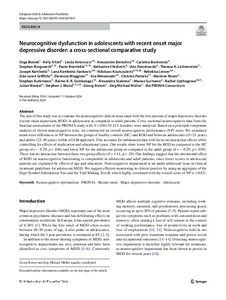Neurocognitive dysfunction in adolescents with recent onset major depressive disorder: a cross-sectional comparative study
Bienek, Olga; Allott, Kelly; Antonucci, Linda; Bertolino, Alessandro; Bonivento, Carolina; Borgwardt, Stephan; Brambilla, Paolo; Chisholm, Katharine; Dannlowski, Udo; Lichtenstein, Theresa K.; Kambeitz, Joseph; Kambeitz-Ilankovic, Lana; Koutsouleris, Nikolaos; Lencer, Rebekka; Griffiths, Sian Lowri; Maggioni, Eleonora; Meisenzahl, Eva; Pantelis, Christos; Rosen, Marlene; Ruhrmann, Stephan; Salokangas, Raimo K. R.; Stainton, Alexandra; Surmann, Marian; Upthegrove, Rachel; Wenzel, Julian; Wood, Stephen J.; Romer, Georg; Mueller, Jorg Michael; PRONIA Consortium
Neurocognitive dysfunction in adolescents with recent onset major depressive disorder: a cross-sectional comparative study
Bienek, Olga
Allott, Kelly
Antonucci, Linda
Bertolino, Alessandro
Bonivento, Carolina
Borgwardt, Stephan
Brambilla, Paolo
Chisholm, Katharine
Dannlowski, Udo
Lichtenstein, Theresa K.
Kambeitz, Joseph
Kambeitz-Ilankovic, Lana
Koutsouleris, Nikolaos
Lencer, Rebekka
Griffiths, Sian Lowri
Maggioni, Eleonora
Meisenzahl, Eva
Pantelis, Christos
Rosen, Marlene
Ruhrmann, Stephan
Salokangas, Raimo K. R.
Stainton, Alexandra
Surmann, Marian
Upthegrove, Rachel
Wenzel, Julian
Wood, Stephen J.
Romer, Georg
Mueller, Jorg Michael
PRONIA Consortium
SPRINGER
Julkaisun pysyvä osoite on:
https://urn.fi/URN:NBN:fi-fe2025082791443
https://urn.fi/URN:NBN:fi-fe2025082791443
Tiivistelmä
The aim of this study was to examine the neurocognitive deficits associated with the first episode of major depressive disorder (recent onset depression, ROD) in adolescents as compared to adult patients. Cross-sectional neurocognitive data from the baseline assessments of the PRONIA study with N = 650 (55.31% females) were analyzed. Based on a principal component analysis of eleven neurocognitive tests, we constructed an overall neurocognitive performance (NP) score. We examined mean score differences in NP between the groups of healthy controls (HC) and ROD and between adolescents (15-21 years) and adults (22-40 years) within a GLM approach. This accounts for unbalanced data with focus on interaction effects while controlling for effects of medication and educational years. Our results show lower NP for the ROD as compared to the HC group (d = - 0.29, p = .046) and lower NP for the adolescent group as compared to the adult group (d = - 0.29; p < .039). There was no interaction between these two group effects (F = 1.11; p = .29). Our findings suggest that the detrimental effect of ROD on neurocognitive functioning is comparable in adolescent and adult patients, since lower scores in adolescent patients are explained by effects of age and education. Neurocognitive impairment is an under addressed issue in clinical treatment guidelines for adolescent MDD. We suggest efficient monitoring in clinical practice by using an aggregate of the Digit Symbol Substitution Test and the Trail Making Test B, which highly correlated with the overall score of NP (r = 0.82).
Kokoelmat
- Rinnakkaistallenteet [27094]
